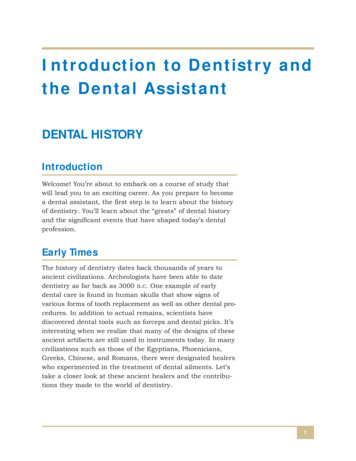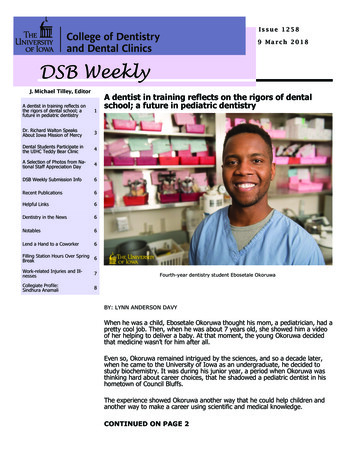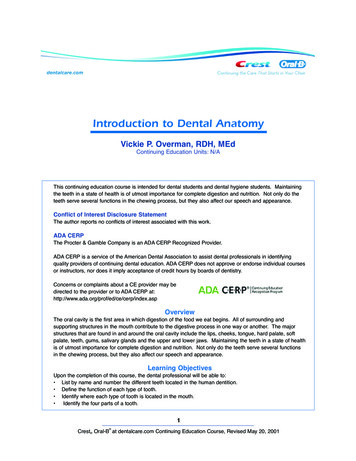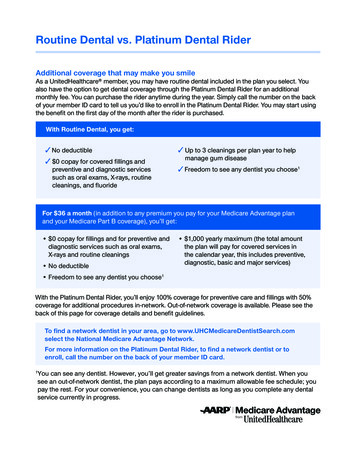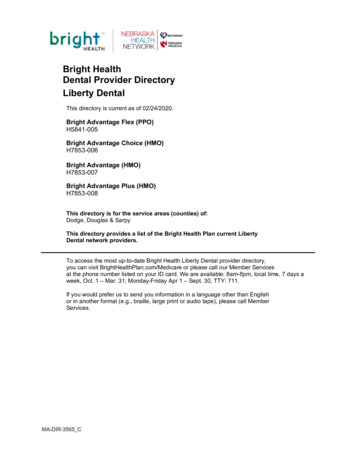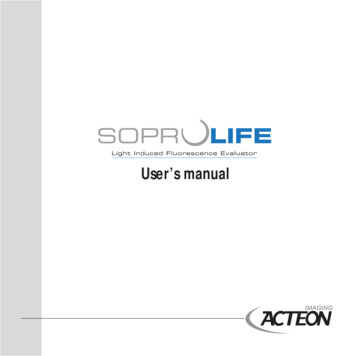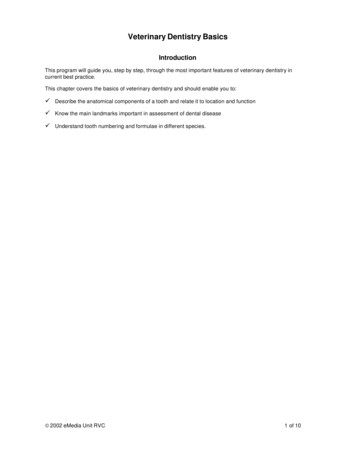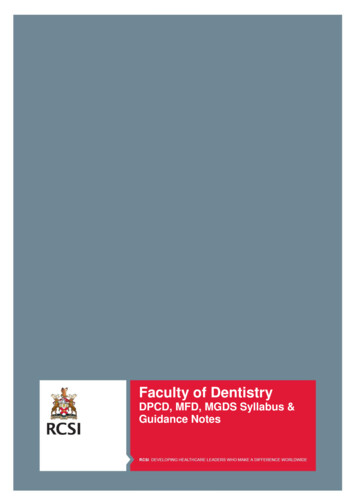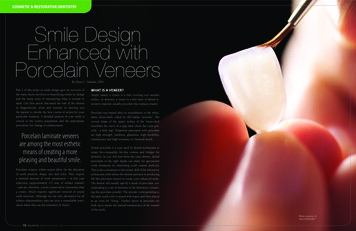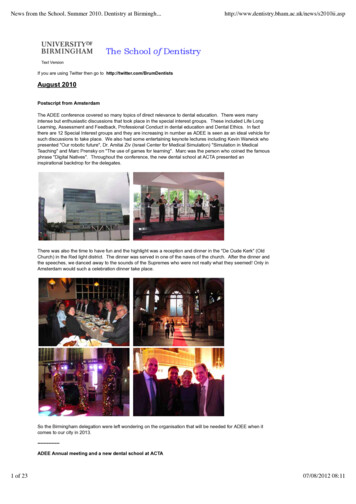
Transcription
Basic Ethics in DentistryThe Academy of Dental Learning and OSHA Training, LLC, designates thisactivity for 3 continuing education credits (3 CEs).Terrie BruscinoHealth Science Editor: Megan Wright, RDH, MSPublication Date: October 2012Updated Date: February 2020Expiration Date: February 2023The Academy of Dental Learning and OSHA Training, LLC is an ADA CERP RecognizedProvider. ADA CERP is a service of the American Dental Association to assist dentalprofessionals in identifying quality providers of continuing dental education. ADA CERP does notapprove or endorse individual courses or instructors, nor does it imply acceptance of credit hoursby boards of dentistry. Concerns or complaints about a CE provider may be directed to theprovider or to the Commission for Continuing Education Provider Recognition at ADA.org/CERP.Conflict of Interest Disclosure: ADL does not accept promotional or commercial funding inassociation with its courses. In order to promote quality and scientific integrity, ADL's evidencebased course content is developed independent of commercial interests. Refund Policy: If youare dissatisfied with the course for any reason, prior to taking the test and receiving yourcertificate, return the printed materials within 15 days of purchase and we will refund your fulltuition. Shipping charges are nonrefundable.California Registered Provider Number: RP5631
Answer Sheet: Basic Ethics In .10.15.20.Name: Profession:License State: License Number: Expiration DateAddressCity: State: Zip Code:Telephone: Fax:E-mail:If you have downloaded the course and printed the answer sheet from the Internet please enterpayment information below.Card type: Card Number:Exp. Date: Name as it appears on card:*To enter your answers online you MUST return to our website www.dentallearning.org.Return answer sheet: Via fax: 518.514.1103Via email: CESupport@dentallearning.comPostal Mail: ADL, PO Box 14585, Albany, NY 12212***PLEASE PRINT CLEARLY; ILLEGIBLE ANSWER SHEETS WILL NOT BEPROCESSED.Notes:1
Course EvaluationPlease place an X in the box to rate thesestatements:PoorFairGoodVeryGoodExcellentThe content fulfills the overall purpose of the course.The content fulfills each of the course objectives.The course subject matter is accurate.The material presented is understandable.The teaching/learning method is effective.The answers to the test questions are appropriatelycovered in the course.How would you rate this course overall?Hours:Time to complete the entire course and the test?Minutes:GoogleOther Search EngineFriend/CoworkerOtherDo you have any suggestions about how we can improve this course? If so please note them on aseparate sheet of paper and send it in with your answer sheet.If you studied the course online, did all the links work? If not please note the page and link on a separatesheet of paper and send it in with your answer sheet so we can fix it.2
Instructions1. Review the Objectives: Objectives provide an overview of the entire course.2. Read the course material.3. Complete the test:a. Return to our website: www.dentallearning.org, click on Take the Exam,enter your answers, register, if you are new customer (existing customerslogin), pay for the course, click Grade Test. Your test will be gradedimmediately. If required, complete the course evaluation. Your certificatewill display for you to print.b. If you would rather, you may return your completed answer sheet andcourse evaluation to us via the options listed below.To successfully complete the course you must score 80% or above on the test. If youdo not score 80% you may retake the test one more time free of charge. If you fail asecond time you must purchase a new course and test.If you’ve downloaded this coursebook off the Internet you can: Return to our website (www.dentallearning.org) to take the test online (only if youhave not purchased the coursebook separately). You will need to provide creditcard information at the time you submit your test online for scoring. Write your answers on the one-page answer sheet included in this book,complete the credit card payment information, and return the form to the addressbelow, fax, or email address below. Or, you may send a check or money order tothe address below with your answer sheet.Academy of Dental Learning and OSHA Training, LLC (ADL)P.O. Box 14585Albany, NY 12212Fax: 518-514-1103Email: CESupport@dentallearning.orgAnswer sheets received without payment will not be processed.We grade all tests in a timely manner; if you do not receive your certificate within fivedays, please email (CESupport@dentallearning.org) or call us: 518-209-9540.There is no time limit for return of your answer sheet. Completion dates are taken fromthe envelope postmark or the finish date recorded in the computer when you do anonline exam. Tests MUST be completed in the licensing cycle you wish to use thecredits.If you are dissatisfied with the course for any reason, prior to taking the test andreceiving your certificate, return the printed materials within 15 days of purchase and wewill refund your full tuition. Shipping charges are nonrefundable.3
If someone else would like to use this material after you are done, he or she mayregister with us and take advantage of a “sharing discount”. Courses downloaded fromthe Internet can be shared at the same tuition rate as currently available on our website.Please call us if you need an extra answer sheet or download one from our website.There is no “sharing discount” for online exams.The author and ADL have made every effort to include information in this course that isfactual and conforms to accepted standards of care. This course is not to be used as asole reference for treatment decisions. It is your responsibility to understand your legalobligations and license requirements when treating patients. ADL is not responsible forthe misuse of information presented in this course. The material in this course cannotbe reproduced or transmitted in any way without the written consent of ADL.4
Table of ContentsAnswer SheetEvaluationInstructionsTable of ContentsObjectivesIntroductionDefinitions of Ethical PrinciplesProfessionalismEthical Decision MakingEthical Dilemmas in DentistryDentist/Patient IssuesEthical Issues in Dental Fees and InsuranceDentist and Colleague/Employee IssuesEthical LawEthical TheoriesApplication of Ethical TheoriesConclusionReferencesCourse Test51235667101113131819202121232426
Objectives Understand what is meant by ethics in Dentistry.Understand the term “profession” and how it relates to ethics in dentistry.Become familiar with elements and principles of ethical decision making.Understand the ethics of patient relations, delegation of duties, substanceabuse in dentistry, financial arrangements, and managed care.Understand the difference between dental law and dental ethics.Define the normative theories of ethics and apply them to ethical issues inpractice.Understand and apply the principals of dental ethics to everyday practice.IntroductionThe word ethics comes from the Greek ethos originally meaning character or conduct. Itis typically used interchangeably with the word moral which is derived from the Latinword mores, which means customs or habits. Together these two terms refer toconduct, character, and motivations involved in moral acts. Thus, ethics are notimposed by a profession or by law, but by moral obligation. Ethics are an unwritten codeof conduct that encompass both professional conduct and judgment. Though the detailsof the written ethical code may vary from profession to profession, the underlyingprinciples of ethics remain the same.As David T. Ozar and David J. Sokol suggest in Dental Ethics at Chairside: ProfessionalPrinciples and Practical Applications, the ethical issues faced by dentists in today’ssociety have become more complex and seem to arise more often than those faced bydentists in the past. Given the current direction of health and dental care, it is essentialthat dental professionals understand and practice wholeheartedly the code that hasbeen set forth by the ADA.6
As with any profession that deals with human rights and liberties, dentists have aresponsibility to their patients and communities in which they practice. Much like theHippocratic Oath, the code of Dental Ethics created by the American Dental Association(ADA) serves as a standard to which all dental professionals are expected to adhere. Itstates that each member of the dental profession is responsible for “maintaining andenriching” the dental profession. It is important that “each member choose to meet” theobligations of the dental profession “according to the dictates of personal consciencebased on the needs of the general public.” Within the code of conduct developed by theADA (found here: http://www.ada.org/prof/prac/law/code/index.asp) there are fivefundamental principles that serve as the codes foundation: patient autonomy,nonmaleficence, beneficence, justice, and veracity.Definitions of Ethical PrinciplesThe five fundamental principles set forth by the ADA require further review so they areapplied to the profession properly. To achieve proper ethical conduct in a dental setting,dentists must first begin by treating each patient as an individual and take true interestin the patient’s dental needs and wants.Patient Autonomy. Is the right of the patient to make his or her own decisions regardingthe treatment that he or she will receive. It was not long ago that the majority of dentaldecisions were left in the hands of the dentist. Now, it is essential that the patient havethe final decision in his or her treatment. The dentist is responsible for providing thepatient with all of the available treatment options, the successes and hardshipsassociated with those treatments, and giving the patient the ability to make a decisionthat is informed and best suits his or her needs. In Ozar and Sokol’s model of thepatient-dentist relationship, the dentist and patient are equal partners in the7
decision making process. This relationship is defined by three areas: they deserveeach other’s respect; each has a set of values; and each comes to the decision-makingprocess about the patient’s oral health with the understanding that information must beshared. Thus, it is essential that the dentist and patient communicate and cooperateeffectively.Nonmaleficence essentially states that a dentist must not cause unnecessary harm to apatient. Obviously in some courses of treatment some pain may be necessary toachieve the desired outcome, however the decision regarding the level of pain that isacceptable to the patient must be determined by the patient. In some situations, theprocedure may have what is known as a “double effect,” meaning that while theprocedure fixes one issue, it initiates or causes another issue to arise. It is imperativethat the dentist keep his or her skills and knowledge of procedures current, know theirlimitations, and know when and under what circumstances it may be acceptable toperform a procedure that may cause a patient harm.Once a dentist begins care for a patient he or she is required to see the treatmentthrough to the end. If for any reason a dentist feels that he or she cannot complete theprocedure, The dentist is obligated to refer the patient to a specialist or colleague.Additionally, if a dentist is called upon for a consultation, it is essential that he or sheshould not have a vested interest in the recommended treatment. It is theresponsibility of the dentist, whether they’re the primary care provider or a consultingdentist, to protect the health of the patient and not expose a patient to increased risks.As in any medical profession, it is the obligation of the dentist to inform immediately anypatient who may have been exposed to blood or any other potentially infectious materialat the dental office. In addition to informing the patient of the exposure, it is theresponsibility of the dentist to immediately refer the patient to a qualified healthcareprovider to obtain post-exposure services and follow-up. This includes providinginformation to the patient concerning the dentist’s own blood borne pathogen status andsubmitting to testing that will assist with the evaluation of the patient. If a third party isthe source of the exposure, it is important that the dentist encourage that individual tocooperate as needed to properly evaluate the exposed patient’s condition.Finally, under nonmaleficence falls the ethical obligation of the dentist to avoidinterpersonal relationships with his or her patients. Such relationships can impair a8
dentist’s ability to properly utilize professional judgment regarding treatment and mayexploit the confidence placed on the dentist by the patient.Beneficence refers to the principle of promoting or doing good. It is essential that thedentist provides competent and timely dental care with the needs, desires, and valuesof the patient given due consideration. This area of ethics has severalcomponents, including: community service such as offering free or discounted dentalcare to the needy, reporting investigative findings that promote or safeguard the healthof the general public (please note that this does not affect the ability of the dentist torequest copyright or patent protection), and reporting symptoms consistent withdomestic violence and child abuse to the proper authorities. Each of these areas servesto elevate the esteem of the profession and addresses the dentist’s responsibility to putthe patient’s welfare first.Justice. Dentists have the responsibility to be fair in their dealings with patients,colleagues, and society. Essentially, the principle of justice embodies the concept tha
Write your answers on the one-page answer sheet included in this book, complete the credit card payment information, and return the form to the address below, fax, or email address below. Or, you may send a check or money order to the address below with your answer sheet. Academy of Dental Learning and OSHA Training, LLC (ADL) P.O. Box 14585File Size: 825KBPage Count: 30
